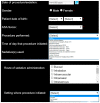Results from the Adverse Event Sedation Reporting Tool: A Global Anthology of 7952 Records Derived from >160,000 Procedural Sedation Encounters
- PMID: 31805686
- PMCID: PMC6947169
- DOI: 10.3390/jcm8122087
Results from the Adverse Event Sedation Reporting Tool: A Global Anthology of 7952 Records Derived from >160,000 Procedural Sedation Encounters
Abstract
Background: The incidence of sedation-related adverse events, inclusive of both adults and children, administered by multiple specialty providers from different countries and venues, using standardized definitions, has never been reported on an international level. We are reporting the outcome data of the adverse event sedation reporting tool as an important step toward a more complete risk assessment of sedation-related morbidity, mortality, and etiology. The analysis of the AE sedation reporting data include descriptive measures to evaluate the characteristics of the provider, the patient, sedations performed, adverse events, interventions, and outcomes. The primary outcome was the rate and nature of adverse events. Between 12/14/2010 and 12/11/2018 there were 7952 sedations, from an estimated total of 164,114 sedations administered, of which 622 were reported as adverse events. The mean age of the entire patient population is 33.0 years (0.02-98.7). The providers represented 39 countries across six continents. Oxygen desaturation (75%-90%) for <60 s is the most prevalent adverse event with a rate of 7.8 per 10,000, followed by airway obstruction at a rate of 5.42 per 10,000. Apnea occurred at a rate of 4.75 per 10,000. Significant predictors of adverse events are ≥ ASA score III (p = 0.0003), procedure time (6:00 pm-12:00 am: p < 0.0001, 12:00-6:00 am: p = 0.0003), and non-hospital location (p < 0.0001). The AE sedation reporting tool has demonstrated that the majority of adverse events in children and adults who receive procedural sedation from multi-specialists internationally required minor interventions and had outcomes of minor risk.
Keywords: adults; children; pediatrics; safety; sedation.
Conflict of interest statement
The authors declare no conflict of interest.
Figures
References
-
- Wadhwa V., Issa D., Garg S., Lopez R., Sanaka M.R., Vargo J.J. Similar Risk of Cardiopulmonary Adverse Events Between Propofol and Traditional Anesthesia for Gastrointestinal Endoscopy: A Systematic Review and Meta-analysis. Clin. Gastroenterol. Hepatol. 2017;15:194–206. doi: 10.1016/j.cgh.2016.07.013. - DOI - PubMed
-
- Srinivasan M., Turmelle M., Depalma L.M., Mao J., Carlson D.W. Procedural sedation for diagnostic imaging in children by pediatric hospitalists using propofol: Analysis of the nature, frequency, and predictors of adverse events and interventions. J. Pediatr. 2012;160:801–806. doi: 10.1016/j.jpeds.2011.11.003. - DOI - PubMed
LinkOut - more resources
Full Text Sources
Medical





